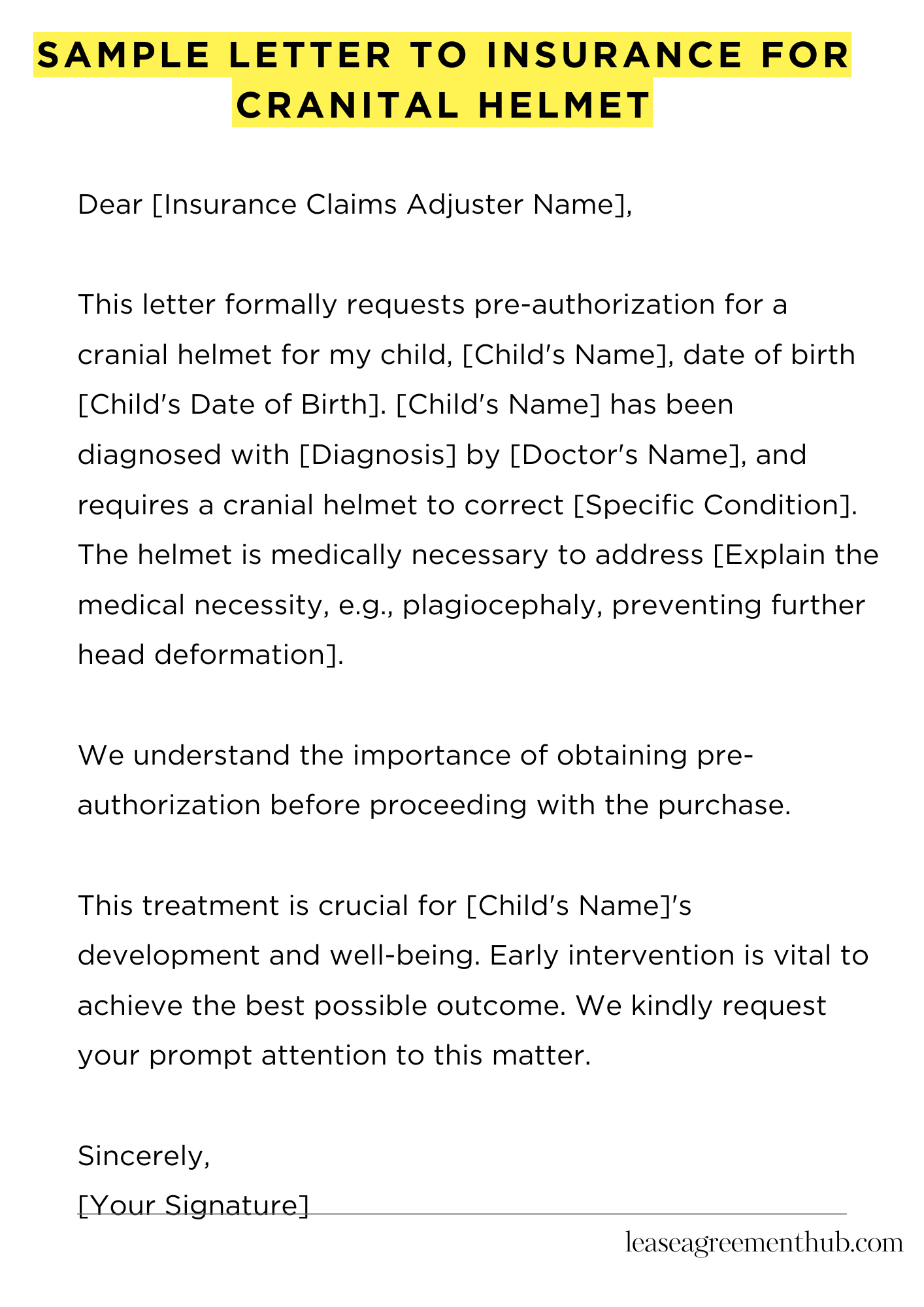A sample letter to your insurance company requests coverage for a cranial helmet. It’s crucial for getting approval.
This article gives you examples of these letters. We provide templates. They make writing your own letter easier.
Use our samples as a guide. Customize them to your situation. Get the coverage you need.
Sample Letter to Insurance for Cranial Helmet
[Your Name]
[Your Address]
[Your Phone Number]
[Your Email Address]
[Date]
[Insurance Company Name]
[Insurance Company Address]
Dear [Insurance Claims Adjuster Name],
This letter formally requests pre-authorization for a cranial helmet for my child, [Child’s Name], date of birth [Child’s Date of Birth]. [Child’s Name] has been diagnosed with [Diagnosis] by [Doctor’s Name], and requires a cranial helmet to correct [Specific Condition]. The helmet is medically necessary to address [Explain the medical necessity, e.g., plagiocephaly, preventing further head deformation].
We understand the importance of obtaining pre-authorization before proceeding with the purchase. Attached you will find all supporting documentation, including the doctor’s prescription, the diagnosis report, and the quote from [Supplier Name] for the cranial helmet. The total cost is [Amount].
This treatment is crucial for [Child’s Name]’s development and well-being. Early intervention is vital to achieve the best possible outcome. We kindly request your prompt attention to this matter. We look forward to your response within [Number] business days. Please contact me if you require any further information.
Sincerely,
[Your Signature]

How to Write a Sample Letter to Insurance for a Cranial Helmet
Understanding Your Insurance Policy: A Necessary Precursor
Before even considering penning your missive, meticulously review your insurance policy. Locate the specifics regarding coverage for medically necessary prosthetics or orthotics. Note any pre-authorization requirements; these are often paramount. Failure to adhere to these stipulations could result in a protracted claims process, or worse, denial of your claim. Pay attention to detail; it’s crucial.
Gathering Essential Documentation: The Cornerstone of Your Case
Assemble all pertinent medical documentation. This includes your child’s diagnosis, the physician’s prescription for the cranial helmet, and any supporting evidence demonstrating the medical necessity of the device. Radiographic images, progress notes, and the physician’s detailed rationale for recommending the helmet are all invaluable. The more comprehensive your submission, the stronger your case.
Structuring Your Letter: Clarity and Conciseness are Key
Begin with a formal salutation, addressing your letter to the appropriate claims department or individual. Clearly state the purpose of your letter – to request coverage for a cranial helmet. Organize your arguments logically, presenting the medical necessity and the cost-effectiveness of the treatment. Keep the language professional, avoiding emotive language. Precision is paramount.
Crafting Compelling Arguments: The Art of Persuasion
Employ a persuasive yet factual approach. Articulate the potential long-term benefits of the cranial helmet, emphasizing its role in mitigating the severity of your child’s condition, and potentially averting future complications. Highlight the cost-effectiveness of the treatment compared to potential future interventions. Support all claims with referenced documentation. Don’t obfuscate; illuminate.
Including Relevant Information: Leave No Stone Unturned
Provide detailed information about the specific cranial helmet prescribed, including the manufacturer, model number, and the estimated cost. Include your policy number and other identifying details. Attach copies of all relevant medical documentation. Ensure all information is easily accessible and well-organized. Meticulousness is paramount.
Following Up on Your Letter: Persistence Pays Off
After submitting your letter, track its progress. Don’t hesitate to follow up with a phone call or email after a reasonable timeframe. If your claim is denied, request a detailed explanation of the denial and explore any available appeal processes. Perseverance and proactive communication are often key to a successful outcome. Don’t be deterred by initial setbacks.
Sample Letter: A Template for Your Correspondence
While a bespoke letter is always preferred, consider this sample as a rudimentary framework: [Insert your Address], [Insert Date], [Insurance Company Address]. Subject: Claim for Cranial Helmet – Policy Number [Your Policy Number]. Dear [Insurance Company Contact Person], I am writing to request coverage for a cranial helmet for my child, [Child’s Name], diagnosed with [Child’s Diagnosis]. [Continue with details from previous sections]. Sincerely, [Your Name and Contact Information]. Remember to tailor this template to reflect your specific circumstances.
FAQs about sample letter to insurance for cranital helmet
What information should I include in my letter requesting insurance coverage for a cranial helmet?
Your letter should clearly state your child’s diagnosis, the medical necessity of the cranial helmet, the type of helmet recommended, and the expected cost. Include your policy number, dates of service, and any relevant medical documentation.
How formal should my letter be?
Maintain a professional and respectful tone. Use clear and concise language, avoiding slang or informal expressions. Proofread carefully for any grammatical errors.
Should I send supporting medical documentation with my letter?
Yes, always include supporting documentation such as your child’s diagnosis from a physician, the prescription for the cranial helmet, and any relevant medical reports. This strengthens your claim.
What if my insurance company denies my claim?
If your claim is denied, review the denial letter carefully. Understand the reasons for denial. You can then appeal the decision, providing additional information or clarification as needed, or seek assistance from a patient advocate.
Where can I find a sample letter to use as a template?
Numerous online resources provide sample letters for requesting medical equipment coverage. However, remember to customize any template with your specific details and information.
Related: